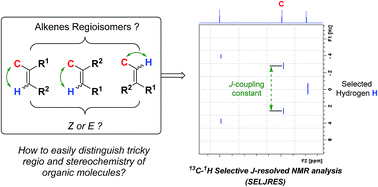Assigning regioisomeric or diastereoisomeric relations of problematic trisubstituted double-bonds through heteronuclear 2D selective J-resolved NMR spectroscopy†
Abstract
Although one of the first 2D NMR methods, but so far neglected, selective J-resolved NMR spectroscopy offers a unique opportunity to help organic chemists in structure elucidation, avoiding natural and non-natural product misassignments. This NMR method indeed allowed us to unambiguously and simply assign (natural) product structures exhibiting trisubstituted unsaturations. For example, as demonstrated here, the isomeric aurone, flavone, coumarin and isocoumarin structures could easily be distinguished; regioisomer assignments in furans could be solved, as well as isomerisms in compounds containing trisubstituted double-bonds (aurones, lactones, divinyl ketones).


 Please wait while we load your content...
Please wait while we load your content...